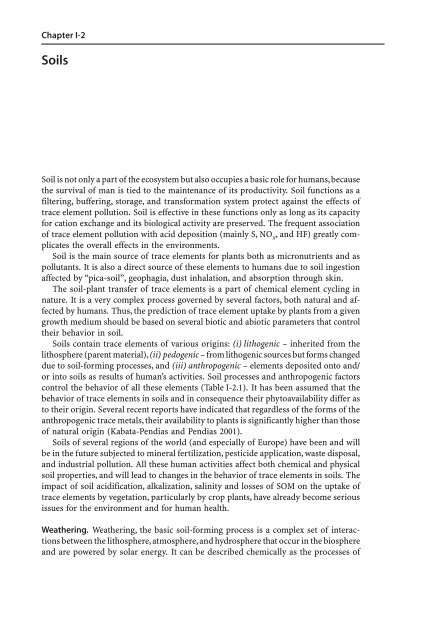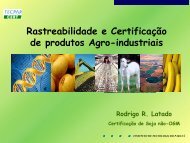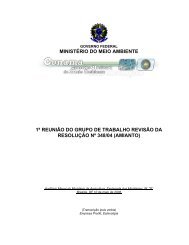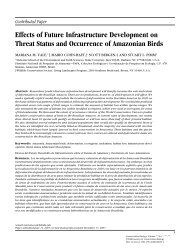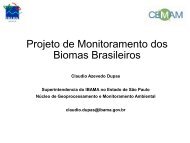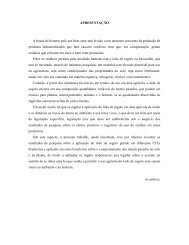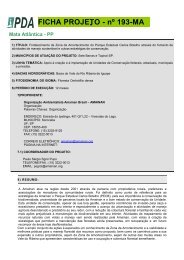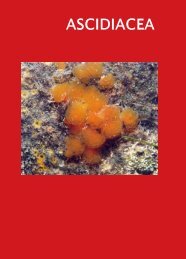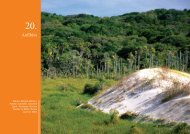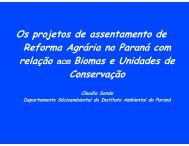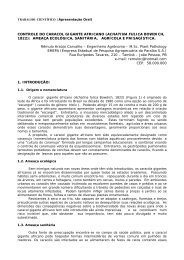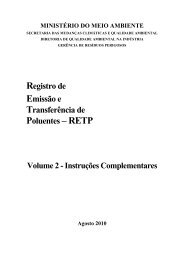Chapter I-2 Soil is not only a part of the ecosystem but also occupies ...
Chapter I-2 Soil is not only a part of the ecosystem but also occupies ...
Chapter I-2 Soil is not only a part of the ecosystem but also occupies ...
You also want an ePaper? Increase the reach of your titles
YUMPU automatically turns print PDFs into web optimized ePapers that Google loves.
<strong>Chapter</strong> I-2<br />
<strong>Soil</strong>s<br />
<strong>Soil</strong> <strong>is</strong> <strong>not</strong> <strong>only</strong> a <strong>part</strong> <strong>of</strong> <strong>the</strong> <strong>ecosystem</strong> <strong>but</strong> <strong>also</strong> <strong>occupies</strong> a basic role for humans, because<br />
<strong>the</strong> survival <strong>of</strong> man <strong>is</strong> tied to <strong>the</strong> maintenance <strong>of</strong> its productivity. <strong>Soil</strong> functions as a<br />
filtering, buffering, storage, and transformation system protect against <strong>the</strong> effects <strong>of</strong><br />
trace element pollution. <strong>Soil</strong> <strong>is</strong> effective in <strong>the</strong>se functions <strong>only</strong> as long as its capacity<br />
for cation exchange and its biological activity are preserved. The frequent association<br />
<strong>of</strong> trace element pollution with acid deposition (mainly S, NO x , and HF) greatly complicates<br />
<strong>the</strong> overall effects in <strong>the</strong> environments.<br />
<strong>Soil</strong> <strong>is</strong> <strong>the</strong> main source <strong>of</strong> trace elements for plants both as micronutrients and as<br />
pollutants. It <strong>is</strong> <strong>also</strong> a direct source <strong>of</strong> <strong>the</strong>se elements to humans due to soil ingestion<br />
affected by “pica-soil”, geophagia, dust inhalation, and absorption through skin.<br />
The soil-plant transfer <strong>of</strong> trace elements <strong>is</strong> a <strong>part</strong> <strong>of</strong> chemical element cycling in<br />
nature. It <strong>is</strong> a very complex process governed by several factors, both natural and affected<br />
by humans. Thus, <strong>the</strong> prediction <strong>of</strong> trace element uptake by plants from a given<br />
growth medium should be based on several biotic and abiotic parameters that control<br />
<strong>the</strong>ir behavior in soil.<br />
<strong>Soil</strong>s contain trace elements <strong>of</strong> various origins: (i) lithogenic – inherited from <strong>the</strong><br />
lithosphere (parent material), (ii) pedogenic – from lithogenic sources <strong>but</strong> forms changed<br />
due to soil-forming processes, and (iii) anthropogenic – elements deposited onto and/<br />
or into soils as results <strong>of</strong> human’s activities. <strong>Soil</strong> processes and anthropogenic factors<br />
control <strong>the</strong> behavior <strong>of</strong> all <strong>the</strong>se elements (Table I-2.1). It has been assumed that <strong>the</strong><br />
behavior <strong>of</strong> trace elements in soils and in consequence <strong>the</strong>ir phytoavailability differ as<br />
to <strong>the</strong>ir origin. Several recent reports have indicated that regardless <strong>of</strong> <strong>the</strong> forms <strong>of</strong> <strong>the</strong><br />
anthropogenic trace metals, <strong>the</strong>ir availability to plants <strong>is</strong> significantly higher than those<br />
<strong>of</strong> natural origin (Kabata-Pendias and Pendias 2001).<br />
<strong>Soil</strong>s <strong>of</strong> several regions <strong>of</strong> <strong>the</strong> world (and especially <strong>of</strong> Europe) have been and will<br />
be in <strong>the</strong> future subjected to mineral fertilization, pesticide application, waste d<strong>is</strong>posal,<br />
and industrial pollution. All <strong>the</strong>se human activities affect both chemical and physical<br />
soil properties, and will lead to changes in <strong>the</strong> behavior <strong>of</strong> trace elements in soils. The<br />
impact <strong>of</strong> soil acidification, alkalization, salinity and losses <strong>of</strong> SOM on <strong>the</strong> uptake <strong>of</strong><br />
trace elements by vegetation, <strong>part</strong>icularly by crop plants, have already become serious<br />
<strong>is</strong>sues for <strong>the</strong> environment and for human health.<br />
Wea<strong>the</strong>ring. Wea<strong>the</strong>ring, <strong>the</strong> basic soil-forming process <strong>is</strong> a complex set <strong>of</strong> interactions<br />
between <strong>the</strong> lithosphere, atmosphere, and hydrosphere that occur in <strong>the</strong> biosphere<br />
and are powered by solar energy. It can be described chemically as <strong>the</strong> processes <strong>of</strong>
10 <strong>Chapter</strong> I-2 · <strong>Soil</strong>s<br />
Table I-2.1. Influence <strong>of</strong> origin <strong>of</strong> trace elements on <strong>the</strong>ir behavior in soil<br />
Table I-2.2. Geochemical classification <strong>of</strong> trace elements (based on data after Rankama and Sahama<br />
vide Fairbridge 1972)<br />
d<strong>is</strong>solution, hydration, hydrolys<strong>is</strong>, oxidation, reduction, and carbonization. All <strong>the</strong>se<br />
processes are guided by <strong>the</strong> rules <strong>of</strong> enthalpy and entropy, and <strong>the</strong>y lead to <strong>the</strong> formation<br />
<strong>of</strong> mineral and chemical components that are relatively stable and equilibrated in<br />
<strong>the</strong> <strong>part</strong>icular soil environment (Pédro 1979). The behavior <strong>of</strong> elements during wea<strong>the</strong>ring<br />
and pedogenic processes are highly associated with <strong>the</strong>ir geochemical proper-
<strong>Chapter</strong> I-2 · <strong>Soil</strong>s<br />
ties, which are base for <strong>the</strong> geochemical classification (Table I-2.2). The majority <strong>of</strong><br />
elements reveal lithophilic character, which indicates a tendency to form oxygen compounds,<br />
as well as silicates, carbonates, phosphates, and sulfates.<br />
Clay minerals, <strong>the</strong> principal products <strong>of</strong> wea<strong>the</strong>ring and soil formation, are due to<br />
water-rock interaction processes. Two types <strong>of</strong> compounds released by organic matter or<br />
organ<strong>is</strong>ms are believed to be <strong>part</strong>icularly involved in wea<strong>the</strong>ring processes: carbonic acid,<br />
formed from <strong>the</strong> CO 2 released during decay <strong>of</strong> organic matter, and organic chelates.<br />
Processes <strong>of</strong> wea<strong>the</strong>ring (degradation) and ne<strong>of</strong>ormation <strong>of</strong> minerals as well as<br />
formation <strong>of</strong> amorphous minerals and organo-mineral substances greatly affect <strong>the</strong><br />
forms and adsorption <strong>of</strong> trace elements in soil. The affinity <strong>of</strong> trace elements for soil<br />
constituents <strong>is</strong> strongly influenced by <strong>the</strong>ir electrochemical properties and <strong>is</strong> closely<br />
related to <strong>the</strong> specific surface area and cation exchange capacity (CEC) <strong>of</strong> <strong>the</strong> minerals.<br />
Some clay minerals, such as montmorillonite, imogolite, vermiculite, and amorphous<br />
allophanes reveal <strong>the</strong> highest sorption capacity (Table I-2.3).<br />
Table I-2.3. Surface area and sorption capacity (CEC) <strong>of</strong> some soil minerals a<br />
11
12 <strong>Chapter</strong> I-2 · <strong>Soil</strong>s<br />
Table I-2.4. Behavior <strong>of</strong> trace elements in various wea<strong>the</strong>ring conditions (after Kabata-Pendias and<br />
Pendias 2001)<br />
Factors controlling <strong>the</strong> complex set <strong>of</strong> chemical wea<strong>the</strong>ring processes <strong>of</strong> minerals in<br />
rocks and soils are: (i) oxidation, (ii) reduction, (iii) hydrolys<strong>is</strong>, (iv) hydration,<br />
(v) solution, and (vi) chelation. All <strong>of</strong> <strong>the</strong>se reactions are controlled by chemical equilibria<br />
<strong>of</strong> <strong>the</strong> <strong>part</strong>icular environment that can be illustrated by <strong>the</strong> Eh-pH diagrams for<br />
<strong>the</strong> given geochemical reactions (Garrels and Chr<strong>is</strong>t 1965). In various wea<strong>the</strong>ring<br />
environments, <strong>the</strong> behavior <strong>of</strong> trace elements differs (Table I-2.4). The electrochemical<br />
properties <strong>of</strong> elements and <strong>the</strong> stability <strong>of</strong> host minerals controls <strong>the</strong> mobility <strong>of</strong><br />
trace elements. In an arid environment, physical wea<strong>the</strong>ring generally occurs, chemical<br />
transformation being ra<strong>the</strong>r poor due to <strong>the</strong> lack <strong>of</strong> water. In a tropical climate with<br />
high temperature and humidity, chemical wea<strong>the</strong>ring <strong>is</strong> favored, resulting in <strong>the</strong> formation<br />
<strong>of</strong> more clay minerals.<br />
Due to <strong>the</strong> variable charge <strong>of</strong> both clays and organic <strong>part</strong>icles, different organomineral<br />
complexes are formed that may greatly influence element mobility in soils<br />
(Tan 1998). Th<strong>is</strong> author has emphasized that various bindings between microorgan<strong>is</strong>ms,<br />
like bacteria and fungi, and soil clays and organic matter, may <strong>also</strong> occur and may<br />
have serious environmental importance.<br />
Pedogenic processes. Pedogenic processes can<strong>not</strong> be easily d<strong>is</strong>tingu<strong>is</strong>hed from wea<strong>the</strong>ring<br />
processes as <strong>the</strong>y take place simultaneously and at <strong>the</strong> same sites; most <strong>of</strong>ten <strong>the</strong>y<br />
are closely interrelated. The principal types <strong>of</strong> <strong>the</strong>se processes include: (i) podzolization,<br />
(ii) alkalization, (iii) aluminization, (iv) laterization, (v) sialization, and (vi) hydromorphic<br />
processes. All <strong>the</strong>se processes control <strong>the</strong> d<strong>is</strong>tri<strong>but</strong>ion and behavior <strong>of</strong> trace elements<br />
in d<strong>is</strong>tinct layers <strong>of</strong> soil pr<strong>of</strong>iles that are related to sorption and desorption and<br />
to <strong>the</strong> formation <strong>of</strong> various species <strong>of</strong> elements.
<strong>Chapter</strong> I-2 · <strong>Soil</strong>s<br />
The main soil parameters governing <strong>the</strong>se processes are: (i) pH and Eh values,<br />
(ii) amount and mineral composition <strong>of</strong> <strong>the</strong> fine granulometric fraction (5: (a) very mobile – none,<br />
(b) mobile – Cd and Zn, and (c) somewhat mobile and scarcely mobile – all o<strong>the</strong>r metals<br />
� Reducing in <strong>the</strong> absence <strong>of</strong> hydrogen sulfide, pH >5: (a) very mobile – none,<br />
(b) mobile – Cd, Cu, Fe, Mn, Pb, Sr, and Zn, and (c) somewhat mobile and scarcely mobile<br />
– all o<strong>the</strong>r metals<br />
� Reducing with hydrogen sulfide, pH >5: (a) very mobile – none, (b) mobile – Mn and<br />
Sr, and (c) scarcely mobile to immobile – all o<strong>the</strong>r metals<br />
It <strong>is</strong> evident that Fe/Mn-rich <strong>part</strong>iculates and hydrogen sulfide are most significant<br />
among <strong>the</strong> abiotic factors in controlling trace metal behavior in <strong>the</strong> terrestrial environment<br />
(Sparks 1995; Bartlett 1999). The relationship between Fe contents and some trace<br />
metals indicates an impact <strong>of</strong> soil Fe on <strong>the</strong> d<strong>is</strong>tri<strong>but</strong>ion <strong>of</strong> some trace metals. However,<br />
th<strong>is</strong> relationship <strong>is</strong> significantly high <strong>only</strong> for Ni (Fig. I-2.1).<br />
All metals that are especially susceptible to redox reactions, e.g., Co, Cr, Fe, and Mn<br />
play a significant role in d<strong>is</strong>solution/precipitation reactions in soil. Th<strong>is</strong> <strong>is</strong> best illustrated<br />
by <strong>the</strong> behavior <strong>of</strong> Mn:<br />
� The reduction <strong>of</strong> Mn 3+ to Mn 2+ by: Fe 2+ , Cr 3+ , Co 2+ , reduced S, phosphate ligands<br />
(e.g., P 2 O 7 4– ), phenols, and o<strong>the</strong>r easily oxidizing organic compounds<br />
� The oxidation <strong>of</strong> Mn 2+ to Mn 3+ or Mn 4+ by: any hydroxyl free radicals or atmospheric<br />
oxygen<br />
� The Mn 3+ <strong>is</strong> an extremely reactive redox species that quickly d<strong>is</strong>appears, ei<strong>the</strong>r by<br />
accepting or by donating an electron<br />
13
14 <strong>Chapter</strong> I-2 · <strong>Soil</strong>s<br />
Fig. I-2.1.<br />
Relative d<strong>is</strong>tri<strong>but</strong>ion index<br />
(RDI) <strong>of</strong> stat<strong>is</strong>tically-significant<br />
relationships between<br />
trace metals and Fe content <strong>of</strong><br />
mineral soils, at <strong>the</strong> 99% confidence<br />
level (after Kabata-<br />
Pendias and Pendias 2001)<br />
O<strong>the</strong>r soil minerals such as, carbonates, phosphates, sulfides, sulfates and chlorides may<br />
have important influences on <strong>the</strong> d<strong>is</strong>tri<strong>but</strong>ion and behavior <strong>of</strong> trace elements in soils developed<br />
under specific geological and climatic conditions (Kabata-Pendias and Sadurski 2004).<br />
<strong>Soil</strong> biota. Living organ<strong>is</strong>ms in soils composed <strong>of</strong> fauna and flora <strong>of</strong> various dimensions<br />
(macro-, meso-, and micro-) are abundant in soils, especially in surface layers. Functions<br />
<strong>of</strong> living organ<strong>is</strong>ms are reflected in biological activity <strong>of</strong> soils and greatly contri<strong>but</strong>e to<br />
bio-physico-chemical processes in soils and soil fertility.<br />
Some species <strong>of</strong> soil mes<strong>of</strong>auna (invertebrates) may easily reflect chemical changes<br />
in soil and are used as sensitive indicators <strong>of</strong> <strong>the</strong> trace metal status <strong>of</strong> soils (Ma 1987).<br />
According to th<strong>is</strong> author <strong>the</strong> concentration factor (ratio <strong>of</strong> worms to soil) varies from<br />
0.1 to 190, being <strong>the</strong> lowest for Pb and <strong>the</strong> highest for Cd. Depending upon soil properties,<br />
th<strong>is</strong> factor <strong>is</strong> <strong>also</strong> variable for a given element. Also Edwards et al. (1998) have concluded,<br />
based on an earthworm bioassay, that many factors hampered quantitative determination<br />
<strong>of</strong> <strong>the</strong> degree <strong>of</strong> metal bioavailability in soil. However, <strong>the</strong>re <strong>is</strong> always observed a general<br />
rule, that Cd <strong>is</strong> <strong>the</strong> most available to earthworms (Worms/<strong>Soil</strong> ratio: 1–37) whereas Cu<br />
and Pb are <strong>the</strong> least available (W/S ratio < 1) (Kabata-Pendias and Pendias 2001).<br />
Trace element contamination causes changes in biochemical parameters <strong>of</strong> soils such as<br />
biomass and species diversity, and microbial activity. Most <strong>of</strong> <strong>the</strong>se parameters have been<br />
used as indices <strong>of</strong> trace element status <strong>of</strong> soils, however, <strong>the</strong>re <strong>is</strong> <strong>not</strong> always a clear relationship.<br />
The impact <strong>of</strong> soil microorgan<strong>is</strong>ms and enzymes on all redox and d<strong>is</strong>solution/precipitation<br />
processes <strong>is</strong> crucial (Burns and Dick 2002; Naidu et al. 2001; Kostyuk and Bunnenberg<br />
1999). The physicochemical relationship between bacteria and mineral surfaces leads to<br />
diverse effects <strong>of</strong> d<strong>is</strong>solution and secondary precipitation <strong>of</strong> trace elements, including<br />
changes in <strong>the</strong>ir valence and/or conversion into organomineral compounds. The waterextractable<br />
F in soils <strong>is</strong> <strong>also</strong> positively correlated with <strong>the</strong> microbial biomass (Tschenko<br />
and Kandeler 1997). The microbial activities are associated with following processes:<br />
� uptake or release <strong>of</strong> an element from a cell<br />
� charge alteration <strong>of</strong> an ion<br />
� complexation <strong>of</strong> an element by various produced compounds<br />
� immobilization <strong>of</strong> an element<br />
� mobilization <strong>of</strong> an element, <strong>of</strong>ten due to <strong>the</strong> methylation
<strong>Chapter</strong> I-2 · <strong>Soil</strong>s<br />
Biological methylation <strong>of</strong> some elements, such as As, Hg, Se, Te, Tl, Pb, and In may<br />
greatly influence <strong>the</strong>ir behavior in soils. Microorgan<strong>is</strong>ms reveal a variable and <strong>of</strong>ten<br />
high sorption capacity to trace elements. Cumulative pools <strong>of</strong> trace elements in <strong>the</strong><br />
mass <strong>of</strong> microbiota has been calculated as follows (g ha –1 ): Ni, 350; Cu, 310; Zn, 250;<br />
Co, 150; Mo, 148; and Pb 8.4, which corresponds to 0.002 to 0.21% <strong>of</strong> <strong>the</strong>ir total abundance<br />
in <strong>the</strong> 20-cm topsoil level (Kovalskiy et al. 1980). Microbioaccumulation <strong>of</strong> trace<br />
elements may be <strong>of</strong> great importance both in <strong>the</strong> cycling <strong>of</strong> elements in soil and in<br />
<strong>the</strong>ir phytoavailability. Increased levels <strong>of</strong> trace elements can d<strong>is</strong>turb soil microbial<br />
processes. On <strong>the</strong> o<strong>the</strong>r hand, bacterial impact on trace metal behavior may be significant,<br />
especially in soil amended with sewage sludge, where bacterial leaching <strong>of</strong><br />
metals have a practical application (Olson 1986). Apparently, soil microorgan<strong>is</strong>ms are<br />
more sensitive than o<strong>the</strong>r terrestrial organ<strong>is</strong>ms to increased levels <strong>of</strong> metals, thus <strong>the</strong><br />
assessment <strong>of</strong> <strong>the</strong>ir toxicity has recently become <strong>the</strong> subject <strong>of</strong> investigations (Brooks<br />
et al. 2005). These authors reported that N fixation in clover <strong>is</strong> <strong>the</strong> most sensitive to<br />
an excess <strong>of</strong> Cd and Zn. However, <strong>the</strong> adverse concentration effects on <strong>the</strong> potential<br />
nitrification rate differs greatly between soils and varied for Cd from 7 to 55 mg kg –1<br />
and for Zn from 107 to 1 764 mg kg –1 . Increased levels <strong>of</strong> F (up to 189 mg F kg –1 ) <strong>is</strong><br />
reported to decrease microbial activity to 5–20% <strong>of</strong> those in <strong>the</strong> uncontaminated soil<br />
(Tschenko and Kandeler 1997).<br />
The microbial activity <strong>is</strong> highly governed by soil properties. As microorgan<strong>is</strong>ms<br />
are involved in SOM transformations, <strong>the</strong>ir activities are associated with organic matter<br />
content. Czaban and Wróblewska (2005) observed that microbial transformation <strong>of</strong><br />
Cd species from <strong>the</strong> solid phase to species soluble in DTPA was lower in fine-texture<br />
soil with low SOM content (1.1% C) than in sandy soil with higher SOM content (4.2%<br />
C). Smolders et al. (2004) have suggested that <strong>the</strong> most significant factor controlling<br />
different reactions <strong>of</strong> microbial processes to increased Zn concentrations <strong>is</strong> <strong>the</strong> variable<br />
community tolerance. Community level <strong>of</strong> physiological pr<strong>of</strong>iles (CLPPs) <strong>of</strong><br />
soil microorgan<strong>is</strong>ms have <strong>not</strong> changed under different levels <strong>of</strong> Cd, Zn, and Pb<br />
that indicate <strong>the</strong>ir developed tolerance to increased contents <strong>of</strong> metals (Nikliôska<br />
et al. 2004).<br />
There are a large number <strong>of</strong> biologically induced minerals (BIM) especially <strong>of</strong> Fe<br />
and Mn. The major metabolic processes that cause deposition and/or d<strong>is</strong>solution <strong>of</strong> Fe<br />
and Mn minerals are oxidation and reduction <strong>of</strong> metal, metal sulfate oxidation, and<br />
metal sulfide reduction (Frankel and Bazylinski 2003).<br />
Mycorrhizal fungi play very specific and important role in <strong>the</strong> uptake <strong>of</strong> trace elements<br />
by plants. There <strong>is</strong> evidence that mycorrhiza play a role in <strong>the</strong> micronutrient<br />
supply to plants (Turnau et al. 1996). The presence <strong>of</strong> mycorrhizal symbios<strong>is</strong> has <strong>also</strong><br />
been demonstrated in plants, especially hyperaccumulating plants which are being used<br />
in <strong>the</strong> phytoextraction <strong>of</strong> metals (Skinner et al. 2005; Turnau et al. 2005). Arbuscular<br />
mycorrhizal fungi (AMF) exhibit various mechan<strong>is</strong>ms in controlling metal uptake by<br />
plants (Biró at al. 2006).<br />
<strong>Soil</strong> solution. Transfer <strong>of</strong> trace elements between soil phases should be considered as<br />
<strong>the</strong> main process controlling <strong>the</strong>ir behavior and bioavailability. The aqueous phase <strong>of</strong><br />
<strong>the</strong> soil (soil solution) <strong>is</strong> composed <strong>of</strong> water with a colloidal suspension, free and/or<br />
complexed, and d<strong>is</strong>solved substances <strong>of</strong> various compounds, including bio-inorganic<br />
15
16 <strong>Chapter</strong> I-2 · <strong>Soil</strong>s<br />
Fig. I-2.2. Common ranges <strong>of</strong> trace metals in <strong>the</strong> solution <strong>of</strong> uncontaminated soils<br />
complexes. Concentrations <strong>of</strong> trace elements in soil solution are closely correlated with<br />
<strong>the</strong>ir mobility and availability. However, <strong>the</strong> soil solution <strong>is</strong> constantly and rapidly<br />
changing in amount and chemical composition <strong>of</strong> species due to contact with highly<br />
diverse soil solid phase and by <strong>the</strong> uptake <strong>of</strong> water and ions by plant roots. Data on<br />
trace element concentrations in soil solution can be useful for <strong>the</strong> prediction <strong>of</strong> <strong>the</strong>ir<br />
phytoavailability and efficiency/toxicity to crops. Chem<strong>is</strong>try <strong>of</strong> <strong>the</strong> soil solution provides<br />
useful information on soil processes that are important to both agricultural and<br />
environmental sciences. Mineral <strong>part</strong>icles <strong>of</strong> biological origin associated with some<br />
prot<strong>is</strong>ts are <strong>also</strong> found in soil solution (Keller 1997).<br />
Methods used for obtaining soil solution differ widely, and <strong>the</strong>refore, it <strong>is</strong> difficult<br />
to determine adequate mean contents <strong>of</strong> trace elements in soil solutions. As Wolt (1994)<br />
stated “No one approach to obtain soil solution <strong>is</strong> appropriate to all applications”.<br />
The concentrations <strong>of</strong> some elements measured in <strong>the</strong> solution obtained by various<br />
techniques from uncontaminated soils are (after Kabata-Pendias and Pendias 2001;<br />
Wolt 1994), as follows (in µg l –1 ): As, 0.01; B, 5–800; Be, 0.1; Cd, 0.08–5; Co, 0.08–29;<br />
Cr, 0.01–29; Cu, 0.5–135; Mn, 25–8 000; Mo, 0.0004–30; Ni, 0.2–150; Pb, 0.005–63; Se, 0.06;<br />
Sn, 0.2; and Zn, 0.1–750. Most comm<strong>only</strong> reported concentrations <strong>of</strong> some metals (Co,<br />
Cr, Cu, Mo, Ni, and Pb) in soil solution are in <strong>the</strong> range between 0.05 and 100 µg l –1<br />
(Fig. I-2.2).<br />
In general, <strong>the</strong> total contents <strong>of</strong> trace elements in solutions <strong>of</strong> uncontaminated<br />
mineral soils range from 1–100 µg l –1 , while in contaminated soils <strong>the</strong>se values can be<br />
much higher. In both kinds <strong>of</strong> soils, however, <strong>the</strong>se are negligible portions <strong>of</strong> <strong>the</strong> total
<strong>Chapter</strong> I-2 · <strong>Soil</strong>s<br />
soil metals. The transfer factor, calculated as ratios <strong>of</strong> metals in solution <strong>of</strong> contaminated<br />
soils to <strong>the</strong>ir contents in solution <strong>of</strong> <strong>the</strong> control soils usually decreases in <strong>the</strong><br />
following order: Cd > Ni > Zn > Cu > Pb > Cr.<br />
Common ion pairs are mainly hydroxides, however several o<strong>the</strong>r complexes are <strong>also</strong><br />
likely to occur in solutions <strong>of</strong> various soils (Table I-2.5). Ion pairs, specific forms <strong>of</strong> oppositely<br />
charged ions that are <strong>the</strong>rmodynamically stable can occur in solutions as manifold<br />
and <strong>of</strong> variable compositions. Complex compounds <strong>of</strong> a relatively high stability constant<br />
occurring in soils solution are: BeF 2 0 , CdCl2 0 , Cd(OH)2 0 , CdSO4 0 , Co(OH)2 0 , Cr(OH)3 0 ,<br />
Cu(OH) 2 0 , FeCl2 0 , FeCl3 0 , Hg(OH)2 0 , MnSO4 0 , Ni(OH)2 0 , PbSO4 0 , Pb(OH)2 0 , VO(OH)3 0 , Zn(OH)2 0 .<br />
Chem<strong>is</strong>try <strong>of</strong> <strong>the</strong> soil solution provides useful information on soil processes that<br />
are important to agricultural and environmental sciences. Data on concentrations <strong>of</strong><br />
trace elements in a “real” soil solution are useful for <strong>the</strong> prediction <strong>of</strong> <strong>the</strong>ir availability,<br />
toxic effects on crops and on biological activities <strong>of</strong> soils. McBride et al. (1997)<br />
have formed an equation for <strong>the</strong> metal solubility as a function <strong>of</strong> some soil properties<br />
(e.g., pH, SOM, and total metal content). The SOM content was <strong>of</strong>ten, <strong>but</strong> <strong>not</strong> always,<br />
a stat<strong>is</strong>tically significant variable in predicting metal solubility, especially Cu. These<br />
authors stated that “Although total metal content alone <strong>is</strong> <strong>not</strong> generally a good predictor<br />
<strong>of</strong> metal solubility or activity, it assumed great importance when comparing metal<br />
solubility in soils having similar pH and organic matter content”.<br />
Table I-2.5. Inorganic ionic species <strong>of</strong> trace elements and iron in soil solutions (after Kabata-Pendias<br />
and Sadurski 2004)<br />
17
18 <strong>Chapter</strong> I-2 · <strong>Soil</strong>s<br />
The <strong>part</strong>itioning <strong>of</strong> trace elements between <strong>the</strong> soil and soil solution determines <strong>the</strong>ir<br />
mobility and bioavailability. However, <strong>the</strong> prediction <strong>of</strong> properties <strong>of</strong> soil solution <strong>is</strong> ra<strong>the</strong>r<br />
difficult, and soph<strong>is</strong>ticated techniques must be applied for <strong>the</strong> extraction <strong>of</strong> undiluted<br />
soil solution as well as special conditions for <strong>the</strong> storage <strong>of</strong> soil/sediment samples.<br />
The concentrations <strong>of</strong> free metal species in soil solution are controlled by several<br />
factors <strong>of</strong> which <strong>the</strong> most significant are <strong>the</strong>rmodynamic/kinetic parameters. Ma<strong>the</strong>matical<br />
approaches to modeling soil solution – solid phase equilibria are broadly<br />
described in numerous publications (Sposito et al. 1984; Waite 1991; Wolt 1994; Sparks<br />
1995; Suarez 1999), and several models for calculating activity coefficients for trace<br />
metals have been overviewed and d<strong>is</strong>cussed. Waite (1991) concluded that: “ma<strong>the</strong>matical<br />
modeling clearly has a place in extending <strong>the</strong> information that can be obtained on<br />
trace element species d<strong>is</strong>tri<strong>but</strong>ed by o<strong>the</strong>r methods and will be <strong>of</strong> practical use in systems<br />
for which determination <strong>of</strong> concentrations <strong>of</strong> all species <strong>of</strong> interest <strong>is</strong> impossible because<br />
<strong>of</strong> sensitivity constraint or o<strong>the</strong>r analytical difficulties”.<br />
Trace element speciation. As soils cons<strong>is</strong>t <strong>of</strong> heterogeneous mixtures <strong>of</strong> different<br />
organic and organic-mineral substances, clay minerals, oxides and hydroxides <strong>of</strong> Fe,<br />
Mn, and Al, and o<strong>the</strong>r solid components as well as a variety <strong>of</strong> soluble substances, <strong>the</strong><br />
binding mechan<strong>is</strong>ms for trace elements and forms <strong>of</strong> <strong>the</strong>ir occurrence in soils are<br />
manifold and vary with <strong>the</strong> composition and physical properties <strong>of</strong> soils.<br />
Great confusion ex<strong>is</strong>ts in <strong>the</strong> use <strong>of</strong> <strong>the</strong> term “speciation” in environmental sciences.<br />
According to Ure et al. (1993), <strong>the</strong> definition <strong>of</strong> speciation in <strong>the</strong> context <strong>of</strong> soils, sediments<br />
and sewage sludge refers to processes <strong>of</strong> identification and quantification <strong>of</strong> <strong>the</strong><br />
different defined species, forms and phases in which an element occurs in investigated<br />
materials. However, most <strong>of</strong>ten “speciation” <strong>also</strong> means <strong>the</strong> description <strong>of</strong> <strong>the</strong> amounts<br />
and kinds <strong>of</strong> ex<strong>is</strong>ting forms <strong>of</strong> trace elements. Whichever approach <strong>is</strong> taken, <strong>the</strong> species,<br />
forms or phases are defined: (i) functionally, (ii) operationally, and/or (iii) as specific<br />
chemical compounds or oxidation states.<br />
Considerable controversy has developed over selective extraction methods to determine<br />
<strong>the</strong> amounts <strong>of</strong> trace elements associated with various soil phases and compounds.<br />
Determination <strong>of</strong> various fractions <strong>of</strong> <strong>the</strong>se elements <strong>is</strong> broadly used, especially for<br />
two purposes: to link with <strong>the</strong> potential bioavailability, and to predict <strong>the</strong> mobility<br />
affecting <strong>the</strong>ir transport within <strong>the</strong> soil pr<strong>of</strong>ile and to ground waters. The speciation<br />
<strong>of</strong> trace metals in soils <strong>is</strong> <strong>not</strong> stable and relatively easy transformation <strong>of</strong> <strong>the</strong>ir forms<br />
in soils <strong>is</strong> observed.<br />
Various concentrations <strong>of</strong> different reagents and variable soil/solution ratios over<br />
broad pH ranges are used for <strong>the</strong> selective extraction procedures. In consequence,<br />
each method gives operational groups <strong>of</strong> metals that are <strong>not</strong> comparable. However,<br />
each method gives an approximate fractionation <strong>of</strong> metals occurring in soils, from<br />
easily mobile to strongly sorbed/fixed forms. All <strong>the</strong>se methods are used for <strong>the</strong> determination<br />
<strong>of</strong> comm<strong>only</strong> d<strong>is</strong>tingu<strong>is</strong>hed metal species which are, in general: (i) easily<br />
exchangeable or water soluble, (ii) specifically sorbed, e.g., by carbonates, or phosphates,<br />
(iii) organically bound, (iv) occluded by Fe/Mn oxides and hydroxides, and<br />
(v) structurally bound in minerals (residual).<br />
Metal species resulting from <strong>the</strong> <strong>part</strong>itioning <strong>of</strong> <strong>the</strong> total metal content that <strong>is</strong> associated<br />
with various solid soil fractions are usually estimated using specific operational
<strong>Chapter</strong> I-2 · <strong>Soil</strong>s<br />
extraction procedures. Comprehensive reviews <strong>of</strong> methods applied for sequential extraction<br />
have been given in several publications (Tessier et al. 1979; Salomons and<br />
Förstner 1984; Brümmer 1986, 1986; Kersten and Förstner 1991; Sauvé 2001; Mortvedt<br />
et al. 1991; Ure and Davidson 1995).<br />
Some authors d<strong>is</strong>tingu<strong>is</strong>h <strong>also</strong> water-soluble fraction <strong>of</strong> metals, which actually corresponds<br />
to a dilute salt solution extract (Boust and Saas 1981; Mathur and Levésque<br />
1988). Solid phase fractionation methods allow separate additional fractions <strong>of</strong> metals,<br />
such as silicate clays, sulfides, and specifically sorbed or precipitated forms.<br />
Various methods used to evaluate <strong>the</strong> pool <strong>of</strong> soluble (phytoavailable) trace elements<br />
in soils are based mainly on extraction by various solutions at different concentrations<br />
(as described by Houba et al. 1999; McLaughlin 2001):<br />
� Acids: mineral acids at various concentrations<br />
� Chelating agents: e.g., EDTA, DTPA<br />
� Buffered salts: e.g., AAAc<br />
� Neutral salts: CaCl 2 , MgCl 2 , NH 4 NO 3 , Sr(NO 3 ) 2<br />
� O<strong>the</strong>r extractants, like Coca Cola, which has been proposed for use in routine soil testing<br />
Several o<strong>the</strong>r techniques like electrodialys<strong>is</strong>, diffusion through membranes, diffusion<br />
gradients in thin films as well as bioindicators have <strong>also</strong> been proposed (Kabata-<br />
Pendias and Sadurski 2004).<br />
According to Houba et al. (1999), solutions <strong>of</strong> a neutral salt, such as CaCl 2 , are <strong>the</strong><br />
most suitable for <strong>the</strong> extraction <strong>of</strong> bioavailable pools <strong>of</strong> metals. Karczewska (2002) has<br />
reported <strong>the</strong> highest proportions <strong>of</strong> metals (up to above 90% <strong>of</strong> total contents <strong>of</strong> Cu,<br />
Pb, and Mn; and up to above 60% <strong>of</strong> Zn) to be extracted from surface horizons <strong>of</strong><br />
polluted soils by <strong>the</strong> following solutions: 0.02 M EDTA-Na, 1 M HCl, and 0.1 M HCl.<br />
Depending upon <strong>the</strong> variability in physico-chemical character<strong>is</strong>tics <strong>of</strong> metals, <strong>the</strong>ir<br />
affinity to soil components governs <strong>the</strong>ir speciation. Rule (1999) broadly reviewed recent<br />
literature on <strong>the</strong> phase d<strong>is</strong>tri<strong>but</strong>ion <strong>of</strong> trace metals in soils, and concluded that <strong>the</strong><br />
highest proportions <strong>of</strong> most metals are found ei<strong>the</strong>r in <strong>the</strong> residual or in Fe-Mn oxide<br />
fractions in both natural and contaminated soils. A high association with <strong>the</strong> exchangeable<br />
fraction was observed <strong>only</strong> for Cd in a few soils. Cadmium and Zn were <strong>also</strong> abundant<br />
in <strong>the</strong> carbonate form in some soils. The association <strong>of</strong> metals with organic matter<br />
was generally low for Cd and Ni, and high for Cu. Herbert (1997) found that Cu, Pb, Ni and<br />
Zn are bound primarily to cation exchange sites and to organic matter in <strong>the</strong> reference<br />
soil, while in <strong>the</strong> polluted soils, metal <strong>part</strong>itioning <strong>is</strong> dominated by Fe oxide fractions,<br />
despite <strong>the</strong> high organic matter content. However, <strong>the</strong> proportion <strong>of</strong> different species <strong>is</strong><br />
highly variable and depends on elements, soils, and seasons (e.g., climatic conditions).<br />
Kernsten and Förstner (1991) presented <strong>the</strong> affinity <strong>of</strong> metals for different minerals:<br />
� Sulfides <strong>of</strong> Fe and Pb are likely to sorb most metals<br />
� Carbonates fix predominantly Cd, Cu, Pb, and Mn<br />
� Fe/Mn nodules (deep-sea) sorb mainly Fe, Mn, Cu, Zn, Ni, and Cr<br />
� Fe crystalline oxides hold, as reducible fractions, Fe, Mn, Cd, and Zn<br />
� Chlorite reveals variable capacity to fix metals, predominantly as reducible and<br />
residual fractions<br />
19
20 <strong>Chapter</strong> I-2 · <strong>Soil</strong>s<br />
It <strong>is</strong> necessary to emphasize, however, that during analytical procedures several<br />
artifacts can occur and create unreal results.<br />
The speciation <strong>of</strong> trace metals in soils <strong>is</strong> related to <strong>the</strong>ir biogeochemical reactivity and<br />
to several physicochemical soil conditions. The determinations <strong>of</strong> various fractions <strong>of</strong> <strong>the</strong>se<br />
elements are broadly used especially for two purposes, to link with <strong>the</strong> potential bioavailability,<br />
and to predict <strong>the</strong> mobility affecting <strong>the</strong>ir transport to groundwater. The speciation<br />
<strong>of</strong> metals in soils <strong>is</strong> <strong>not</strong> stable, and <strong>the</strong> transformation <strong>of</strong> <strong>the</strong>ir forms in soil <strong>is</strong> observed.<br />
An example can be <strong>the</strong> relatively rapid transformation <strong>of</strong> metals (Cd, Zn, Pb) applied to<br />
soils as oxides into exchangeable and carbonate species (Kabata-Pendias and Pendias 2001).<br />
Trace element speciation analys<strong>is</strong> provides a bas<strong>is</strong> for <strong>the</strong> description <strong>of</strong> forms and<br />
compounds in which <strong>the</strong>y occur in soils. O<strong>the</strong>r definitions are <strong>also</strong> used to define <strong>the</strong><br />
properties <strong>of</strong> trace elements in soils. The general term “availability” has been recently<br />
described as: geoavailability, geochemical availability, biogeochemical availability and<br />
bioavailability (Wolt 1994; Smith and Huyck 1999). “Geoavailability” <strong>is</strong> defined as that<br />
portion <strong>of</strong> <strong>the</strong> total content <strong>of</strong> a chemical element or a compound in an earth material that<br />
can be liberated to <strong>the</strong> surficial (soil) environment. “Geochemical availability” <strong>is</strong> related<br />
to that fraction <strong>of</strong> a chemical element that <strong>part</strong>icipates in transport processes affecting<br />
<strong>the</strong> spatial d<strong>is</strong>tri<strong>but</strong>ion and changes over time. “Biogeochemical availability” <strong>is</strong> defined as<br />
<strong>the</strong> quantity-intensity factor calculated as a ratio <strong>of</strong> total content to <strong>the</strong> concentration <strong>of</strong><br />
a trace element in soil solution. “Bioavailability” refers to <strong>the</strong> fraction <strong>of</strong> a trace element<br />
that <strong>is</strong> or has been available to an organ<strong>is</strong>m.<br />
In spite <strong>of</strong> intensive investigations (sequential extractions and specific extractants)<br />
on <strong>the</strong> prediction <strong>of</strong> <strong>the</strong> availability <strong>of</strong> trace metals, good estimations <strong>of</strong> general<br />
bioavailability <strong>of</strong> a given trace element are needed. However, based on results <strong>of</strong> longterm<br />
experiments, some specific extractants, as well as weak neutral salt solutions seem<br />
to be adequate to assess <strong>the</strong> impact <strong>of</strong> trace elements on plants and soil bioactivity.<br />
Trace element interactions. Interactions between chemical elements both micro and<br />
macro may have an antagon<strong>is</strong>tic and/or synerg<strong>is</strong>tic character. Although most <strong>of</strong> <strong>the</strong>se<br />
interactions are associated with physiological processes in plants some reactions are<br />
<strong>also</strong> related to pedochemical processes. These are mainly impacts <strong>of</strong> major elements<br />
on <strong>the</strong> d<strong>is</strong>tri<strong>but</strong>ions and forms <strong>of</strong> some trace elements in soils. The main antagon<strong>is</strong>tic<br />
interactions (or relationships) in soils, <strong>of</strong>ten associated with microbiota, are reported<br />
by Kabata-Pendias and Pendias (2001) for:<br />
� Ca and B, Ba, Cd, Co, Cr, Cs, Li, Mn, Ni, Pb, Sr, and Zn<br />
� P and As, Cr, Hg, Mo, Mn, Ni, Pb, Rb, Se, and Zn<br />
� Mg and Cr, Mn, Zn, Ni, Co, and Cu<br />
� Fe and Co, Ni, Mn, Mo, Cr, and Zn<br />
� Mn and As, Cr, Cu, Mo, Ni, V, and Zn<br />
� Cu and Mo<br />
� Cd and Zn<br />
Interactions between elements in soils are <strong>of</strong> multivariant character <strong>but</strong> may be<br />
mainly attri<strong>but</strong>ed to <strong>the</strong> sorption sites <strong>of</strong> soils <strong>part</strong>icles and <strong>also</strong> to <strong>the</strong> surface root<br />
cells and to root exudates.
<strong>Chapter</strong> I-2 · <strong>Soil</strong>s<br />
Trace element occurrence. Contents <strong>of</strong> trace elements in soil materials from natural<br />
as well as from contaminated sites show great variability in both <strong>the</strong> horizontal and<br />
vertical dimensions. The heterogeneity <strong>of</strong> soils, especially at <strong>the</strong> microscale, creates<br />
real problems in representative sampling that have serious impacts on <strong>the</strong> reproducibility<br />
and comparability <strong>of</strong> analytical data. Th<strong>is</strong> <strong>is</strong> <strong>of</strong> great concern in <strong>the</strong> assessment<br />
<strong>of</strong> background (pr<strong>is</strong>tine) contents <strong>of</strong> trace elements in soils. Although a real pr<strong>is</strong>tine<br />
status <strong>of</strong> trace elements in soils does <strong>not</strong> ex<strong>is</strong>t nowadays, even in remote regions, some<br />
values <strong>of</strong> trace elements in “uncontaminated” soils are prerequ<strong>is</strong>ites as reference values<br />
for <strong>the</strong> evaluation <strong>of</strong> soil pollution. Several methods were developed to calculate background<br />
contents <strong>of</strong> trace elements in soils. The best-known methods are, as presented<br />
(from various sources) by Kabata-Pendias and Pendias (2001):<br />
� GB: Geochemical Baseline<br />
� GD: Index <strong>of</strong> Geochemical D<strong>is</strong>tri<strong>but</strong>ion<br />
� IGL: Index <strong>of</strong> Geochemical Load<br />
� IPD: Index <strong>of</strong> Pedogenic D<strong>is</strong>tri<strong>but</strong>ion<br />
� PEF: Pedochemical Enrichment Factor<br />
� FSP: Factor <strong>of</strong> <strong>Soil</strong> Parameters<br />
� SCV: Spatial Concentration Variability<br />
� GIS and MA: Geographical Information System and Multivariate Analyses<br />
The fine granulometric soil fraction (
22 <strong>Chapter</strong> I-2 · <strong>Soil</strong>s<br />
Table I-2.6. Mean (arithmetic) and maximum values (mg kg –1 ) <strong>of</strong> <strong>the</strong> background contents <strong>of</strong> some<br />
trace elements a in two common soil kinds on <strong>the</strong> worldwide scale<br />
Organic matter <strong>also</strong> plays a significant role in sorption <strong>of</strong> trace elements. Most<br />
kinds <strong>of</strong> SOM have a relatively high specific surface area and common range <strong>of</strong> CEC<br />
(at pH 8) <strong>is</strong> calculated to be in <strong>the</strong> range from 60 to 300 cmol(+)kg –1 (Baldock and<br />
Nelson 2000). The CEC values <strong>of</strong> SOM are governed to a great extent by acidity and<br />
increase from 36 cmol(+)kg –1 at pH 2.5 to 215 cmol(+)kg –1 at pH 8 (Sparks 1995).<br />
The contri<strong>but</strong>ion <strong>of</strong> SOM to <strong>the</strong> CEC <strong>is</strong> significant, and varies from 25 to 90%, depending<br />
on soil categories.<br />
In several soils or in some layers <strong>of</strong> soil horizons, oxides and hydroxides <strong>of</strong> Fe and<br />
Mn play very important roles in <strong>the</strong> d<strong>is</strong>tri<strong>but</strong>ion and behavior <strong>of</strong> trace elements, and<br />
may fix great amounts <strong>of</strong> some trace metals, especially <strong>of</strong> Co (up to 0.3%) and Ni (up<br />
to 0.5%) (see Table II-7.3). The Fe and Mn hydroxides occur in soils as concretions<br />
and/or nodules, as well as coatings on soil <strong>part</strong>icles, and as fillings in cracks and veins.<br />
The large database <strong>of</strong> recent surveys <strong>of</strong> trace elements in soils allows general estimations<br />
to be made <strong>of</strong> <strong>the</strong> concentration means in soils <strong>of</strong> various countries (Table I-2.7).<br />
The background populations <strong>of</strong> trace elements in soils, both uncontaminated and<br />
contaminated, seem to be log-normally d<strong>is</strong>tri<strong>but</strong>ed, though with much higher extremes<br />
in contaminated ones.
<strong>Chapter</strong> I-2 · <strong>Soil</strong>s<br />
Many elements are likely to be accumulated in <strong>the</strong> surface soil layer (SEFcrust > 1).<br />
However, some elements, e.g., Te, Se, Pd, Pt, Cd, Ge, Cl, As, Sb, Br, and Hf are significantly<br />
enriched in soils as compared to <strong>the</strong>ir crustal abundance (SEFcrust from >2 to 16).<br />
The surface soil layer, enriched in organic matter (mainly humus) <strong>is</strong> an important<br />
sink for trace element deposition from <strong>the</strong> atmosphere. The investigation <strong>of</strong> trace<br />
metals in organic surface soils in Fennoscandia, sampled in 1995, has shown a general<br />
impact <strong>of</strong> long-range transport <strong>of</strong> pollutants (Steinnes and Rühling 2002). There was<br />
observed a much smaller influence <strong>of</strong> regional differences in geochem<strong>is</strong>try <strong>of</strong> <strong>the</strong> underlying<br />
bedrocks than <strong>of</strong> aerial pollution. The ranges <strong>of</strong> trace metals were following (in<br />
mg kg –1 , expressed in range <strong>of</strong> < and >): As, 0.4–2; Cd, 0.2–1; Cu, 4–12; Fe, 1 000–5 000;<br />
Hg, 0.1–0.5; Ni, 2–10; Pb, 10–60; V, 3–15; and Zn, 30–110.<br />
<strong>Soil</strong> pollution. Both terms, contamination and pollution, are used synonymously.<br />
According to <strong>the</strong> definition given by Knox et al. (1999) trace element contaminated<br />
soils are <strong>not</strong> considered to be polluted unless a threshold concentration ex<strong>is</strong>ts that begins<br />
to affect biochemical and biological processes.<br />
<strong>Soil</strong> pollution <strong>is</strong> as old as man’s ability to smelt and process ores, and goes back as far as<br />
<strong>the</strong> Bronze Age (2500 BC). Ernst (1998b) comprehensively reviewed ancient metal contamination<br />
from <strong>the</strong> Bronze Age to Roman times. Almost all human activities have resulted in<br />
increased levels <strong>of</strong> trace elements in soils. The trace elements from anthropogenic sources<br />
ex<strong>is</strong>t mainly on <strong>the</strong> surfaces <strong>of</strong> soils as reactive forms and may occur as: water-soluble, exchangeable,<br />
associated with organic matter, carbonate, oxides <strong>of</strong> Fe, Al and Mn and silicates<br />
(Ma and Uren 1998; Ramos et al. 1994). Sources <strong>of</strong> trace inorganic contaminants (TIC) are:<br />
� Industrial activities<br />
– Mining and smelting <strong>of</strong> metalliferous ores<br />
– Brick and pipe manufacture<br />
– Cement manufacture<br />
– O<strong>the</strong>rs, e.g., ceramic, glass, chemical plants<br />
� Power generation<br />
– Burning <strong>of</strong> fossil fuel<br />
– Nuclear reactors<br />
– Incineration <strong>of</strong> municipal wastes<br />
� Agricultural practices<br />
– <strong>Soil</strong> amendment with sewage sludge<br />
– Application <strong>of</strong> manure<br />
– Mineral fertilizers<br />
– Pesticides, fumigation<br />
� Transport and urban-derived pollution<br />
� Long-range transport <strong>of</strong> pollutants<br />
Energy and mineral consumption by humans <strong>is</strong> <strong>the</strong> main cause <strong>of</strong> contamination<br />
<strong>of</strong> <strong>the</strong> biosphere. The ratio <strong>of</strong> mined trace elements to <strong>the</strong>ir deposition in contemporary<br />
geological sediments may indicate <strong>the</strong>ir potential threat to <strong>the</strong> environment. Based<br />
on such calculations, Bowen (1979) has found that <strong>the</strong> most dangerous to <strong>the</strong> biosphere<br />
are following elements: Ag, Au, Cd, Cr, Cu, Hg, Pb, Sb, Tl, and Zn. Among <strong>the</strong><br />
23
24 <strong>Chapter</strong> I-2 · <strong>Soil</strong>s<br />
Table I-2.7. Comm<strong>only</strong> reported mean background contents <strong>of</strong> trace elements in continental crust and surface soils (mg kg –1 )
Table I-2.7. Continued<br />
<strong>Chapter</strong> I-2 · <strong>Soil</strong>s<br />
25
26 <strong>Chapter</strong> I-2 · <strong>Soil</strong>s<br />
Table I-2.8. World mining <strong>of</strong> <strong>the</strong> elements in 2000 and 2003 (t, kt, Mt yr –1 )<br />
least dangerous elements are: Ga, La, Nb, Sr, Ta, and Zr. Data for <strong>the</strong> world mining <strong>of</strong><br />
trace elements differ between 2000 and 2003, and <strong>also</strong> depend on <strong>the</strong> source <strong>of</strong> data<br />
(Table I-2.8). The residence time <strong>of</strong> trace metals in surface soils depends on several<br />
soil properties <strong>of</strong> which pH and Eh parameters are <strong>the</strong> most significant. As Bowen<br />
(1979) has reported, <strong>the</strong> maximum residence time (in years) may be: (i) 1 000 for Cd,<br />
Hg, and Be, (ii) 3 000 for Zn and As, and (iii) 6 000 for Pb.<br />
The natural sources <strong>of</strong> trace elements are associated mainly with continental and<br />
volcanic dust, although some elements easily released from <strong>the</strong> ocean surface (e.g., I<br />
and Se) contri<strong>but</strong>e to <strong>the</strong>ir elevated contents in soils <strong>of</strong> some <strong>ecosystem</strong>s. According to<br />
Korzh (1991) <strong>the</strong> deposition <strong>of</strong> trace elements from oceans via <strong>the</strong> atmosphere onto<br />
soils are at <strong>the</strong> rate (in t yr –1 ):<br />
� 10 4 –10 6 : Li, Rb, Mo, I, Ba, B, Br, F, and Sr<br />
� 10 2 –10 3 : Cr, Mn, Fe, Cu, Ga, Se, Y, Zr, Cd, W, TI, Ti, V, Ni, Zn, As, Sb, Cs and U<br />
� 1 –10: Be, In, Eu, Pr, Nd, Sm, Gd, Dy, Ho, Er, Yb, Hf, Ta, Re, Au, Hg, and Pb
<strong>Chapter</strong> I-2 · <strong>Soil</strong>s<br />
Cosmic <strong>part</strong>icles that are deposited on <strong>the</strong> Earth at rates <strong>of</strong> 100–1 000 t d –1 may <strong>also</strong><br />
be, though mainly unrecognized, a source <strong>of</strong> some trace elements (Dodd 1981). However,<br />
as indicated by data presented by Kjølholt (1997), <strong>the</strong> atmospheric deposition <strong>of</strong><br />
trace metals from natural sources <strong>is</strong> negligible compared with <strong>the</strong>ir loads with products<br />
used for soil amendment (Table I-2.9). The highest amounts <strong>of</strong> trace metals are<br />
added to agricultural soils with <strong>the</strong> application <strong>of</strong> sewage sludge, compost with biosolids,<br />
and fly ash (Table I-2.10). Th<strong>is</strong> may change, however, depending on <strong>the</strong> soil system and<br />
on variable factors that affect <strong>the</strong> trace element status <strong>of</strong> soils (Fig. I-2.4). Inputs <strong>of</strong><br />
trace metals to soil on both animal and crop farms may be quite significant, however<br />
Table I-2.9. Loads <strong>of</strong> trace elements (g ha –1 yr –1 ) from various products applied on Dan<strong>is</strong>h agricultural<br />
soils and from aerial deposition (after Kjølholt 1997)<br />
Fig. I-2.4. Factors affecting <strong>the</strong> trace element status <strong>of</strong> various soil systems<br />
27
28 <strong>Chapter</strong> I-2 · <strong>Soil</strong>s<br />
Table I-2.10. Mean contents <strong>of</strong> trace elements in fertilizers, sewage sludge, and fly ash (adopted from Eriksson 2001a, unless o<strong>the</strong>rw<strong>is</strong>e stated)
<strong>Chapter</strong> I-2 · <strong>Soil</strong>s<br />
<strong>the</strong>y vary depending on <strong>the</strong> farm, <strong>the</strong> country, and <strong>the</strong> metal (Table I-2.11). The highest<br />
annual net gain has been calculated, among European countries, for Cu and Zn in dairy<br />
farms in France. The balance for <strong>the</strong> same elements was negative in dairy farms <strong>of</strong><br />
Norway. Crop farms may generate higher inputs, than animal farms, <strong>of</strong> trace metals to<br />
soils. However, <strong>the</strong>re <strong>is</strong> <strong>also</strong> observed a great variation between farm types and th<strong>is</strong><br />
depends mostly on crop and soil types. Balances for trace metals in crop-farm soils are<br />
presented in <strong>the</strong> AROMIS database (Eckel et al. 2005) as follows (in g ha –1 yr –1 ):<br />
� Cd: from –0.3 in Denmark to 4.4 in France<br />
� Cr: from 14 in Denmark to 100 in France<br />
� Cu: from –35 in France to 347 in Germany<br />
� Ni: from –3.3 in Denmark to 33 in France<br />
� Pb: from 1.3 in Norway to 139 in France<br />
� Zn: from –115 in Germany to 838 in France<br />
Table I-2.11. Trace metal balance (g ha –1 yr –1 ) for livestock farms in some EU countries, selected data<br />
from <strong>the</strong> AROMIS data base (after Eckel et al. 2005)<br />
29
30 <strong>Chapter</strong> I-2 · <strong>Soil</strong>s<br />
Budgets <strong>of</strong> trace metals in soils <strong>of</strong> forest <strong>ecosystem</strong>s are <strong>also</strong> variable, however, <strong>the</strong>y<br />
are more <strong>of</strong>ten negative than in agricultural soils. The highest negative balances were<br />
calculated (in <strong>the</strong> 1970s and 1980s) for spruce forest soils (in Sweden) and for Fe and<br />
Mn (Tyler, Bergkv<strong>is</strong>t vide Kabata-Pendias and Pendias 2001).<br />
Trace element budgets have been calculated for various <strong>ecosystem</strong>s, and <strong>the</strong> ratio <strong>of</strong><br />
input/output, show that for <strong>the</strong> majority <strong>of</strong> elements, <strong>the</strong> accumulation rate in surface<br />
soils <strong>is</strong> positive. However, in some European forest soils with a high rate <strong>of</strong> mobility<br />
and leaching <strong>of</strong> trace metals, a decrease <strong>of</strong> <strong>the</strong>se elements <strong>is</strong> observed, even with relatively<br />
high inputs to soils. The highest losses, under such conditions, have been reported<br />
mainly for Mn (up to 6 100 g ha –1 yr –1 ) and for Fe (up to 11 000 g ha –1 yr –1 ) (Kabata-<br />
Pendias and Pendias 2001). It has been estimated, that in most European <strong>ecosystem</strong>s,<br />
and in <strong>part</strong>icular in agricultural soils, <strong>the</strong> input <strong>of</strong> most metals <strong>is</strong> higher than <strong>the</strong>ir<br />
losses. Th<strong>is</strong> <strong>is</strong> especially pronounced for Zn, Pb and Cd. The calculation <strong>of</strong> Cd budgets<br />
for two soils, in Germany and Poland, has indicated that <strong>the</strong> point source <strong>of</strong><br />
pollution and long-range transport <strong>is</strong> about equal to nonpoint source <strong>of</strong> pollution,<br />
which <strong>is</strong> mainly from agricultural practices. The net gain balances for Cd range (in<br />
gha –1 yr –1 ) between 4.5–7.5 and 1.3–40 for Poland and Germany, respectively (Kabata-<br />
Pendias and Brümmer 1991).<br />
The transport <strong>of</strong> d<strong>is</strong>solved trace elements may take place through <strong>the</strong> soil solution<br />
(diffusion) and with <strong>the</strong> moving soil solution (mass flow, leaching). In soils formed<br />
under a humid and cool climate, <strong>the</strong> leaching <strong>of</strong> elements downward through <strong>the</strong> pr<strong>of</strong>iles<br />
<strong>is</strong> greater than <strong>the</strong>ir accumulation, unless <strong>the</strong>re <strong>is</strong> a higher input <strong>of</strong> <strong>the</strong>se elements<br />
into <strong>the</strong> soils. In warm and dry climates, and to some extent in humid hot climates,<br />
upward translocation <strong>of</strong> trace elements in <strong>the</strong> soil pr<strong>of</strong>iles <strong>is</strong> relatively common. Several<br />
soil properties control leaching processes, <strong>of</strong> which <strong>the</strong> most important may be<br />
considered soil texture and <strong>the</strong> Eh-pH system.<br />
Radionuclide contamination. Nuclear power generation has been utilized since <strong>the</strong><br />
mid-1950s. As Fuge (2005) has described, accidental leakage and permitted effluence<br />
have released some radionuclides, mainly to <strong>the</strong> immediate environment <strong>of</strong> <strong>the</strong> nuclear<br />
installations. The explosion at <strong>the</strong> Chernobyl nuclear station (presently in Ukraine) in<br />
April 1986 caused widespread contamination that seriously affected some European<br />
countries and several o<strong>the</strong>r <strong>part</strong>s <strong>of</strong> <strong>the</strong> world.<br />
More important radioactive <strong>is</strong>otopes released by <strong>the</strong> Chernobyl accident, according<br />
to Becker-Heidmann and Scharpensel (1990), are as follows:<br />
� Short half-life time (days): 141 Ce, 132 Te, 133 Xe, 131 I, 99 Mo, 95 Zr, and 89 Sr<br />
� Longer half-life time (years): 134 Cs, 85 Kr, 137 Cs, 103 Ru, and 90 Sr<br />
� Long half-life time (hundreds <strong>of</strong> years): 238–240 Pu, and 241 Am<br />
The artificial radioactivity <strong>of</strong> soils <strong>is</strong> caused by settling <strong>of</strong> <strong>the</strong> released radionuclides.<br />
The fallout <strong>of</strong> Chernobyl’s <strong>is</strong>otopes varied greatly and <strong>the</strong> nonhomogenous d<strong>is</strong>tri<strong>but</strong>ion<br />
<strong>is</strong> <strong>part</strong>ly associated with <strong>the</strong> wet precipitation (rainfall) during that period.<br />
The behavior <strong>of</strong> <strong>is</strong>otopes in soil depends on several soil properties, as well as on <strong>the</strong><br />
specific behavior <strong>of</strong> each radionuclide. The d<strong>is</strong>tri<strong>but</strong>ion, fate, and phytoavailability <strong>of</strong><br />
137 Cs (half-life 30 years) have been investigated most frequently (Sheppard 2003).
<strong>Chapter</strong> I-2 · <strong>Soil</strong>s<br />
The highest radioactive contamination <strong>of</strong> surface soils <strong>of</strong> Poland, after <strong>the</strong><br />
Chernobyl explosion was observed in <strong>the</strong> southwestern <strong>part</strong> <strong>of</strong> <strong>the</strong> country. The concentrations<br />
<strong>of</strong> 137 Cs in soils <strong>of</strong> those regions were at <strong>the</strong> range 5–13 kBq m –2 . During<br />
<strong>the</strong> period 1988–2001 <strong>the</strong> country average concentration <strong>of</strong> th<strong>is</strong> <strong>is</strong>otope dimin<strong>is</strong>hed<br />
from about 4.6 to 3.2 kBq m –2 (Biernacka et al. 2004).<br />
Urban soils. Contamination <strong>of</strong> urban soils has recently become <strong>the</strong> subject <strong>of</strong> several<br />
studies (Kasimov 1995; de Miquel et al. 1997; Kabata-Pendias and Krakowiak 1998; Umfitseva<br />
and Terekhina 2005). Recently reported levels <strong>of</strong> some trace metals in various<br />
soils, e.g., in China may be a real hazard to <strong>the</strong> environment and health (Table I-2.12).<br />
There are several sources <strong>of</strong> trace element pollution in <strong>the</strong> urban environment, among<br />
which roadside dust may be a significant one, due to <strong>the</strong>ir increased contents in fuels<br />
and road materials (Table I-2.13).<br />
Based on investigations <strong>of</strong> soil pollution in Oslo and Madrid, some trace metals<br />
have been d<strong>is</strong>tingu<strong>is</strong>hed as so-called “urban” contaminants: Ba, Cd, Pb, Sb, Ti, and Zn<br />
(de Miquel et al. 1997). However, <strong>the</strong> pollution <strong>of</strong> cities <strong>is</strong> specific and varies with local<br />
conditions. The trace elements increased in soils <strong>of</strong> some cities as compared with<br />
surrounding soils are reported as follows:<br />
� Berlin: Cd, Cu, Hg, Ni, Pb, Sn, Th, Tl (Birke and Rauch 1994)<br />
� Minsk: Cd, Pb, and Zn (Pietukhova et al. 1996)<br />
� Novosibirsk: As, Br, Cd, Cu, Hg, Mo, Pb, Zn, and Zr (Ilyin 1997)<br />
� Sankt-Petersburg: Ba, Cr, Cu, Pb, V, W, and Zn (Umfitseva and Terekhina 2005)<br />
� Toronto, increase in house dust against street dust: Cd, Cu, Hg, Pb, Sn (Rasmussen<br />
et al. 2001)<br />
� Warsaw: Ba, Cd, Cr, Cu, Li, Ni, Pb, Sr, and Zn (Kabata-Pendias and Krakowiak 1998)<br />
Table I-2.12. Concentrations (<strong>the</strong> highest reported contents) <strong>of</strong> some trace elements in soils contaminated<br />
from industrial sources in selected countries (mg kg –1 ) (various sources, as compiled by Kabata-<br />
Pendias and Pendias 2001, unless o<strong>the</strong>rw<strong>is</strong>e indicated)<br />
31
32 <strong>Chapter</strong> I-2 · <strong>Soil</strong>s<br />
Table I-2.13. Trace metals in samples contri<strong>but</strong>ing to roadside dust (after Ozaki et al. 2004). Samples<br />
collected during <strong>the</strong> period 2001–2002 in Japan<br />
As reported by Umfitseva and Terekhina (2005), most <strong>of</strong> o<strong>the</strong>r trace elements <strong>also</strong><br />
are increased in urban soils as compared with soils <strong>of</strong> surrounding areas (Table I-2.14).<br />
Increased levels <strong>of</strong> some trace metals in house dust as compared with both street dust<br />
and garden soils may be a significant source <strong>of</strong> metallic pollutants, and may pose a r<strong>is</strong>k<br />
especially to children.<br />
<strong>Soil</strong> remediation. The remediation <strong>of</strong> soils refers to practices <strong>of</strong> ei<strong>the</strong>r removing contaminants<br />
or converting <strong>the</strong>m into to less mobile species – that <strong>is</strong>, into less bioavailable<br />
forms. Remediation methods are based on physical, chemical and biological approaches.<br />
The selection <strong>of</strong> a method <strong>is</strong> generally based on <strong>the</strong> nature <strong>of</strong> <strong>the</strong> contaminants,<br />
<strong>the</strong> soil type, <strong>the</strong> character<strong>is</strong>tics <strong>of</strong> <strong>the</strong> contaminated site (e.g., chemical and<br />
physical soil properties, and <strong>the</strong> length <strong>of</strong> <strong>the</strong> soil contamination period). Also<br />
remediation costs and regulations <strong>of</strong> <strong>the</strong> country are involved in remediation projects<br />
(Alloway 1995; Mukherjee 2001).<br />
Methods for remediating metal-polluted soils have been recently widely investigated<br />
and d<strong>is</strong>cussed (Sparks 1995; Adriano et al. 1998; Cunningham and Berti 2000; Iskandar<br />
2001; Knox et al. 2000). The remediation <strong>of</strong> soils and sites contaminated with radionuclides<br />
<strong>is</strong> <strong>of</strong> special concern. Several techniques, in situ and non-in situ are applied to<br />
clean up soils contaminated with trace metals. Due to <strong>the</strong> complexity <strong>of</strong> soils and <strong>the</strong><br />
presence <strong>of</strong> multiple contaminants, <strong>only</strong> a few <strong>of</strong> <strong>the</strong>se techniques have been applied<br />
successfully in practice and some <strong>of</strong> <strong>the</strong>m are quite costly. Most comm<strong>only</strong> used<br />
remediation technologies (in-situ and non-in-situ methods) are:
Table I-2.14.<br />
Trace elements and iron in<br />
soils <strong>of</strong> central Sankt-Petersburg<br />
and <strong>of</strong> <strong>the</strong> surrounding<br />
region (mg kg –1 ) (after Umfitseva<br />
and Terekhina 2005)<br />
<strong>Chapter</strong> I-2 · <strong>Soil</strong>s<br />
� Leaching/washing/flushing – soil with water or surfactant (a surface active substance),<br />
<strong>not</strong> very comm<strong>only</strong> practiced, limited due to <strong>the</strong> need for large quantities <strong>of</strong> water,<br />
results depend strongly on physical soil parameters<br />
� Solidification/stabilization/immobilization – soil amendments with materials having<br />
a high capacity to bind metals in possible slightly mobile fractions and/or immobilize<br />
by keeping a neutral soil pH, for effectiveness required site-specific data,<br />
relatively low cost<br />
� Biodegradation – substances containing trace metals are decomposed due to microbial<br />
degradation, trace pollutants are mobilized and washed-out, long-term effects,<br />
practiced in specific sites<br />
� Vitrification – pollutants are immobilized with an electric current, seldom used,<br />
very costly<br />
� Isolation/containment – minimizing downward migration <strong>of</strong> pollutants by installing<br />
subsurface barriers: e.g., clay layer, organo-clay layer, plastic liner<br />
� Encapsulation – covering small sites with a layer <strong>of</strong> material <strong>of</strong> a low permeability<br />
(e.g., clay) to prevent water percolation and wind-blown dust<br />
33
34 <strong>Chapter</strong> I-2 · <strong>Soil</strong>s<br />
� Immobilization <strong>of</strong> trace metals, e.g., by steel shots, containing mainly Fe oxides, which<br />
adsorb or occlude several trace metals, by phosphoric compounds which decrease<br />
<strong>the</strong> mobility <strong>of</strong> most metals<br />
� Phytoremediation – <strong>the</strong> phytoextraction techniques provide an adequate method<br />
under reasonable yield <strong>of</strong> plants that hyperaccumulate metals, prom<strong>is</strong>ing in practice,<br />
needs development <strong>of</strong> technology, relatively low cost<br />
� Removal – <strong>the</strong> contaminated soil <strong>is</strong> exposed to chemical extraction and/or <strong>the</strong>rmal<br />
treatment to remove volatile elements or compounds, and to o<strong>the</strong>r leaching or<br />
immobilizing processes, high costs<br />
� Excavation – <strong>the</strong> contaminated soil <strong>is</strong> removed and d<strong>is</strong>posed elsewhere (e.g., in<br />
prepared landfills), high cost and possible problem with groundwater contamination<br />
The problem <strong>of</strong> concern in soil remediation actions <strong>is</strong> <strong>the</strong> cost. Phytoremediation<br />
techniques are likely to be less costly than those based on conventional technologies.<br />
At present, an urgent requirement for phytoextraction <strong>is</strong> to increase <strong>the</strong> yield <strong>of</strong> plants<br />
that hyperaccumulate metals from soils, and to develop adequate technologies for <strong>the</strong><br />
utilization <strong>of</strong> <strong>the</strong> plant materials.<br />
Agricultural practices have <strong>also</strong> been applied to soil remediation. Most comm<strong>only</strong>,<br />
<strong>the</strong> uptake <strong>of</strong> metals by plants <strong>is</strong> dimin<strong>is</strong>hed by keeping a neutral soil pH and by<br />
amendments with materials having a high capacity to bind metals in possibly slightly<br />
Table I-2.15.<br />
Mean (arithmetic) contents <strong>of</strong><br />
trace elements in street dust,<br />
garden soils and house dust<br />
<strong>of</strong> Ottawa, Canada (mg kg –1 )<br />
(after Rasmussen et al. 2001;<br />
samples collected in 1993)
<strong>Chapter</strong> I-2 · <strong>Soil</strong>s<br />
mobile fractions. Various materials are used for soil amendments and remediation.<br />
These are mainly: lime, phosphate fertilizers, zeolites, montmorillonite clays, humic<br />
(organic) matter, and biosolids. The beneficial effects <strong>of</strong> <strong>the</strong>se treatments are broadly<br />
d<strong>is</strong>cussed by some authors (Adriano et al. 1995; Cunningham and Berti 2000; Iskandar<br />
2001; Pierzynski et al. 2000).<br />
In general, <strong>the</strong> phytotoxicity <strong>of</strong> trace metals are severe at low pH, thus liming <strong>is</strong> a<br />
very common practice to prevent <strong>the</strong>ir phytoavailability. However, site effects <strong>of</strong> liming<br />
are a decreased mobility <strong>of</strong> o<strong>the</strong>r metal micronutrients. Th<strong>is</strong> has been clearly demonstrated<br />
by Siebielec and Chaney (2006) who found Mn deficiency in plants grown in<br />
soil limed to remediate Ni-phytotoxicity.<br />
According to Adriano et al. (2004), using agricultural chemicals (e.g., lime, phosphate<br />
compounds, organic compounds) metals may be immobilized in soils. Such<br />
a natural attenuation has been reported by several authors to be very effective in reducing<br />
<strong>of</strong> <strong>the</strong> bioavailability <strong>of</strong> metals (Knox et al. 2000a,b; Basta et al. 2001; Naidu<br />
et al. 2006).<br />
The Maximum Allowable Concentrations (MAC) for trace metals, differ greatly<br />
between countries (Table I-2.16). Generally, lower concentrations are for light sandy<br />
soils and for low range <strong>of</strong> soil pH 5–6. In most countries, <strong>the</strong> perm<strong>is</strong>sible value for soil<br />
Pb <strong>is</strong> 100 mg kg –1 , whereas in <strong>the</strong> UK, it <strong>is</strong> 300 mg kg –1 . In <strong>the</strong> Ne<strong>the</strong>rlands, <strong>the</strong> perm<strong>is</strong>sible<br />
value <strong>of</strong> soil Cd <strong>is</strong> reported to be 0.8 mg kg –1 , <strong>but</strong> in o<strong>the</strong>r European countries th<strong>is</strong><br />
value <strong>is</strong> 3 mg kg –1 (McGrath 1992; Gzyl 1995).<br />
Table I-2.16.<br />
Ranges <strong>of</strong> Maximum Allowable<br />
Concentrations (MAC) and<br />
Trigger Action Value (TAV) for<br />
trace metals in agricultural<br />
soils (mg kg –1 )<br />
35
36 <strong>Chapter</strong> I-2 · <strong>Soil</strong>s<br />
Phytoremediation. Phytoremediation <strong>is</strong> an environmental cleanup strategy in which<br />
plants and <strong>the</strong>ir root-bound microbial community are used to absorb and remove trace<br />
elements in <strong>the</strong> contaminated soil and to translocate <strong>the</strong>m to plant t<strong>is</strong>sues (Robinson<br />
et al. 2003).<br />
Field trails <strong>of</strong> accumulation <strong>of</strong> Ni and Zn in wild plants grown in metal contaminated<br />
sludge confirmed <strong>the</strong> feasibility <strong>of</strong> phytoextraction. In th<strong>is</strong> process, plants act as<br />
bio-pumps to remove contaminants and water from growth media. These processes<br />
can be divided into three following sections:<br />
� Phytostabilization – binding <strong>of</strong> trace metals (metalloids) in an aerobic environment<br />
in <strong>the</strong> root zone<br />
� Phytoextraction – increased uptake <strong>of</strong> trace metals, mainly by hyperaccumulating<br />
plants, process that should be continued for several seasons to obtain an effect<br />
� Phyt<strong>of</strong>iltration/rhiz<strong>of</strong>iltration – absorption <strong>of</strong> metals (metalloids) in root t<strong>is</strong>sues<br />
due to chelation and surface absorption from both soil and groundwater<br />
Recently, several papers have been publ<strong>is</strong>hed on th<strong>is</strong> topic (Baker et al. 1994; Cunningham<br />
et al. 1995; McGrath et al. 2001; Fitz and Wenzel 2002; Wenzel et al. 2003; Prasad<br />
2004b, 2006; Chaney et al. 1997).<br />
Hyperaccumulators are plants and/or ge<strong>not</strong>ypes that accumulate metals much above<br />
common concentrations. At present, <strong>the</strong>re are about 400 species that are known as<br />
hyperaccumulator plants (Robinson et al. 2003). As Greger (1999) showed, based on a<br />
literature review, hyperaccumulators may contain trace metals in leaves above <strong>the</strong> following<br />
levels (in mg kg –1 ):<br />
� 100 – Cd<br />
� 1 000 – Co, Cu, Ni, and Pb<br />
� 10 000 – Mn and Zn<br />
Various wild plants species are known as hyperaccumulators, depending on growth<br />
conditions and contaminant. Most comm<strong>only</strong> Alyssum, Thlaspi, and Astragalus species<br />
are proposed for <strong>the</strong> phytoextraction <strong>of</strong> Ni, Zn, and Se, respectively. These plants,<br />
however, usually give a low yield and th<strong>is</strong> limits <strong>the</strong>ir effectiveness. Thus, a number <strong>of</strong><br />
cereal crops, such as wheat, rice, rye, oats, barley, corn, and sorghum, have been recently<br />
proposed to be used for phytoremediation, since <strong>the</strong>y can tolerate relatively high<br />
concentrations <strong>of</strong> metals (Huang and Cunningham 1996; Kashem and Singh 2001;<br />
Schmidt 2003; Shtangeeva et al. 2001).<br />
The application <strong>of</strong> phytoremediation procedures for <strong>the</strong> clean up <strong>of</strong> highly contaminated<br />
soils has been widely d<strong>is</strong>cussed (Shtangeeva 2006). Calculated amounts <strong>of</strong><br />
trace elements that are removed with plant yield are relatively small. Even accumulator<br />
plants withdraw, mainly from topsoils, about 10% <strong>of</strong> Cd, <strong>the</strong> most readily available<br />
metal (Table I-2.17). The utilization <strong>of</strong> crops enriched in metals <strong>is</strong> a serious problem<br />
that has to be always included in <strong>the</strong> application <strong>of</strong> any phytoremediation methods.<br />
Such biomass could be used for <strong>the</strong> production <strong>of</strong> ethanol and straw (<strong>of</strong> corn and cereals)<br />
and can be burned for <strong>the</strong> production <strong>of</strong> heat and electricity. Seeds <strong>of</strong> sunflower, which<br />
<strong>is</strong> quite effective in <strong>the</strong> accumulation <strong>of</strong> Cu and Pb from contaminated soils, can be
Table I-2.17. Trace element removal with plants from soils (after Kabata-Pendias 1994)<br />
<strong>Chapter</strong> I-2 · <strong>Soil</strong>s<br />
used for <strong>the</strong> production <strong>of</strong> bio-fuels (Kayser et al. 2000). Any yield <strong>of</strong> biomass that<br />
contains elevated amounts <strong>of</strong> metals <strong>is</strong> a hazardous waste which needs specific technologies<br />
to be utilized for <strong>the</strong> production <strong>of</strong> heat and energy or o<strong>the</strong>r secondary products.<br />
The ash from biomass power plants containing metals (e.g., Zn and Cd) can be<br />
recycled to recover <strong>the</strong>se metals (MacDougall et al. 1997).<br />
Some plants reveal a special capability to accumulate a specific element. For example,<br />
ladder brake (Pter<strong>is</strong> vittata L.), a terrestrial fern, can contain large amounts <strong>of</strong><br />
As, up to 23 000 mg kg –1 (Ma et al. 2001). The unique properties <strong>of</strong> Chinese brake fern<br />
has great importance in <strong>the</strong> clearing <strong>of</strong> As contaminated soils by <strong>the</strong> phytoremediation<br />
process. The laboratory study conducted by Tu et al. (2002) indicated that th<strong>is</strong> plant<br />
might take up to 7 230 mg As kg –1 within 20 weeks. Tu and Ma (2003) reported that <strong>the</strong><br />
addition <strong>of</strong> phosphates <strong>is</strong> an important strategy in improving <strong>the</strong> removal <strong>of</strong> As from<br />
contaminated soils by use <strong>of</strong> Chinese brake.<br />
The phytovolatilization method can be applied for elements which are highly volatile,<br />
such as Se, As and Hg. It <strong>is</strong> <strong>not</strong> clear whe<strong>the</strong>r or <strong>not</strong> terrestrial plants can volatilize<br />
As in significant quantities. However, volatilization <strong>of</strong> As may occur by <strong>the</strong> rhizospheric<br />
bacteria <strong>of</strong> terrestrial plants (Salt et al. 1998). It <strong>is</strong> <strong>also</strong> reported that transgenic plants<br />
(Arabidops<strong>is</strong>) are very effective for volatilization <strong>of</strong> Hg (Watanabe 1997). Rugh et al.<br />
(1996) suggested a molecular genetic approach to <strong>the</strong> transfer <strong>of</strong> Hg res<strong>is</strong>tance genes<br />
to plant species as a potential means <strong>of</strong> phytovolatilization <strong>of</strong> Hg 0 . According to <strong>the</strong>se<br />
authors th<strong>is</strong> technique may be useful to remove Hg from contaminated soils. In addition,<br />
it <strong>is</strong> possible to manipulate <strong>the</strong> transfer <strong>of</strong> Hg 0 in plant shoot t<strong>is</strong>sue to Hg 2+ that<br />
may be a<strong>not</strong>her option for <strong>the</strong> Hg phytoremediation. Some plants may convert Se into<br />
dimethyl selenium that <strong>is</strong> nontoxic and may volatilized from plant t<strong>is</strong>sues.<br />
Phytovolatilization mechan<strong>is</strong>ms are <strong>not</strong> yet fully understood. There are observations<br />
that some commercial vegetables (e.g., broccoli, cabbage) and rice are quite<br />
37
38 <strong>Chapter</strong> I-2 · <strong>Soil</strong>s<br />
effective in <strong>the</strong> phytovolatilization. These processes, however, are controlled by soil<br />
factors, such as sulfates and salinity <strong>of</strong> soils.<br />
Economic aspects are very significant in phytoremediation practices (Thewys 2006).<br />
There <strong>is</strong> <strong>not</strong> much information in th<strong>is</strong> field, as well as on farmers’ approaches to th<strong>is</strong><br />
problem. Lewandowski et al. (2005) have recently studied th<strong>is</strong> topic in Germany and<br />
widely d<strong>is</strong>cussed <strong>the</strong> income expected from cleaned up areas and <strong>the</strong> length <strong>of</strong> period<br />
<strong>the</strong> area can be used for <strong>the</strong> production <strong>of</strong> food crops. Th<strong>is</strong> information <strong>is</strong> quite valuable<br />
for farmers and landowners. The authors have d<strong>is</strong>tingu<strong>is</strong>hed important parameters,<br />
such as: (i) length <strong>of</strong> time needed for remediation and (ii) time for production <strong>of</strong><br />
crops after remediation.<br />
The cost <strong>of</strong> and socio-economic aspects <strong>of</strong> phytoremediation has been recently<br />
d<strong>is</strong>cussed and two alternative crops have been considered: rape and willow (Thewys<br />
2006). However, using <strong>the</strong> biomass as a source <strong>of</strong> energy, especially rape oil for biodiesel<br />
creates a r<strong>is</strong>k <strong>of</strong> uncontrolled em<strong>is</strong>sion <strong>of</strong> trace inorganic pollutants.<br />
According to Chaney et al. (1999b), hyperaccumulator plants <strong>of</strong>fer a new sustainable<br />
economic system based on <strong>the</strong> use <strong>of</strong> biomass from <strong>the</strong> phytoremediation for power<br />
generation factories. There <strong>is</strong> a belief that phytoremediation processes may be economically<br />
acceptable in about 10 years time. However, possible r<strong>is</strong>ks <strong>of</strong> food and forage<br />
chain contamination and <strong>the</strong> reaction <strong>of</strong> plants when overloaded with metallic<br />
pollutants, have become open questions (Keller 2006).<br />
The effectiveness <strong>of</strong> some plants in <strong>the</strong> extraction <strong>of</strong> metals from constructed wetland<br />
purification systems have recently become widely investigated in both laboratory<br />
and field conditions (Ofelder et al. 2006; Marmiroli et al. 2006). Some plants (e.g.,<br />
Phragmites, Salix, and Populus) may remove more than 50% <strong>of</strong> metals (Ba, Cd, Cu, Ni,<br />
Pb, Sr) from <strong>the</strong> growth media (Samecka-Cymerman et al. 2004).


